As The Economy Recovers, The Travel, Auto, And Restaurant Industries Can Find “Ready To Go” Consumers With AM/FM Radio And Podcasts
Click here to view or download the full post-pandemic categories deck
As vaccinations become more widespread, America is continuing to reemerge from the pandemic. From employee recruitment to consumer confidence and media consumption, life is beginning to return to normal:
- In light of a tightened labor force, companies are looking to hire new employees.
- Consumer confidence has shattered records, with sentiment surpassing levels seen before the pandemic, according to Ipsos.
- Geopath data reveals miles traveled has recovered to nearly pre-pandemic levels with more and more Americans venturing out of the home.
- In PPM markets, AM/FM radio’s audience reach for April 2021 was the highest since the pandemic started, notching a 98% recovery index versus March 2020, according to Nielsen.
With all signs pointing to a positive recovery, how should advertisers proceed?
To help in determining a path forward, CUMULUS MEDIA | Westwood One analyzed a recently released Nielsen study to uncover which media audiences have the greatest purchase propensity.
Nielsen consumer study: More Americans are “ready to go” than ever
Over the last year, Nielsen has conducted five consumer studies probing sentiment on COVID-19, consumers’ use of AM/FM radio and podcasts, and spending optimism.
Their most recent national wave was conducted in March 2021 among 1,009 consumers. Three consumer segments representing varying degrees of post-COVID-19 normalcy were examined.
The “wait and see” consumers are those do who do not feel things are normalizing or opening up. The “proceed with caution” consumers are those in the middle on opening up. The “ready to go” segment is most optimistic about a return to normalcy.
In the March 2021 study, 61% of consumers considered themselves “ready to go,” up from 53% in October of last year.
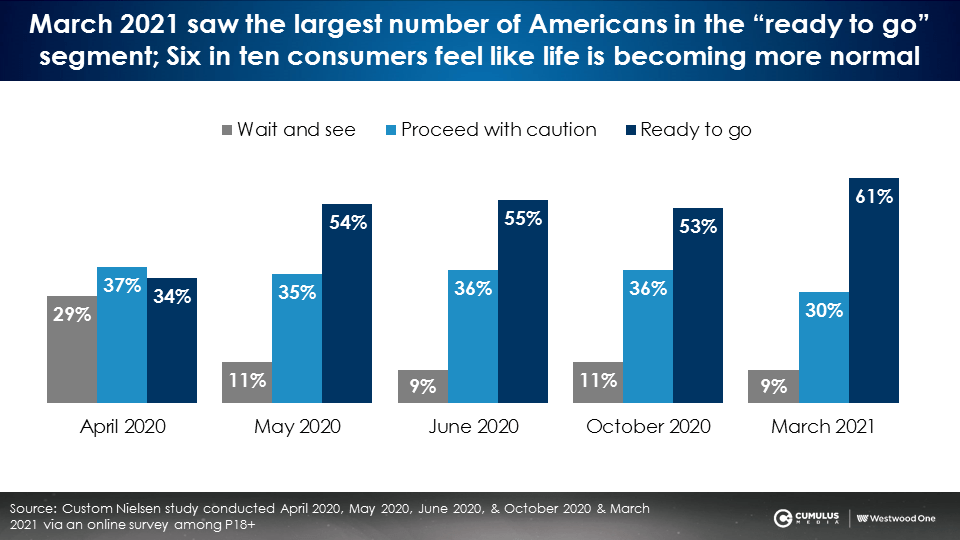
The “ready to go” segment perceives less risk, feels safer, and indicates their cities are emerging from crisis
95% of the “ready to go” segment agree that people are starting to resume normal activities. 92% point positively to stores reopening while 90% view their cities and towns emerging from the crisis. The majority feel safer than they did a month ago.
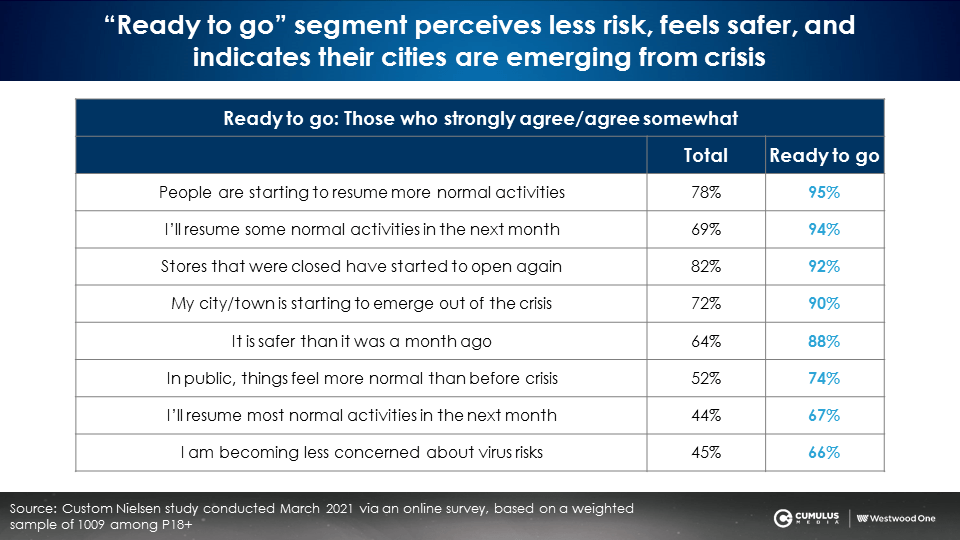
The “ready to go” segment is an attractive consumer group made up of AM/FM radio listeners
In the “ready to go” segment, advertisers can find a desirable consumer group that over indexes in having children aged 2-11 (117), having an annual income of $100K+ (113), and working outside of the home (114).
The “ready to go” consumers are also more likely to be AM/FM radio listeners. Compared to the average, the “ready to go” consumers are 5% more likely to listen to AM/FM radio in a typical day.
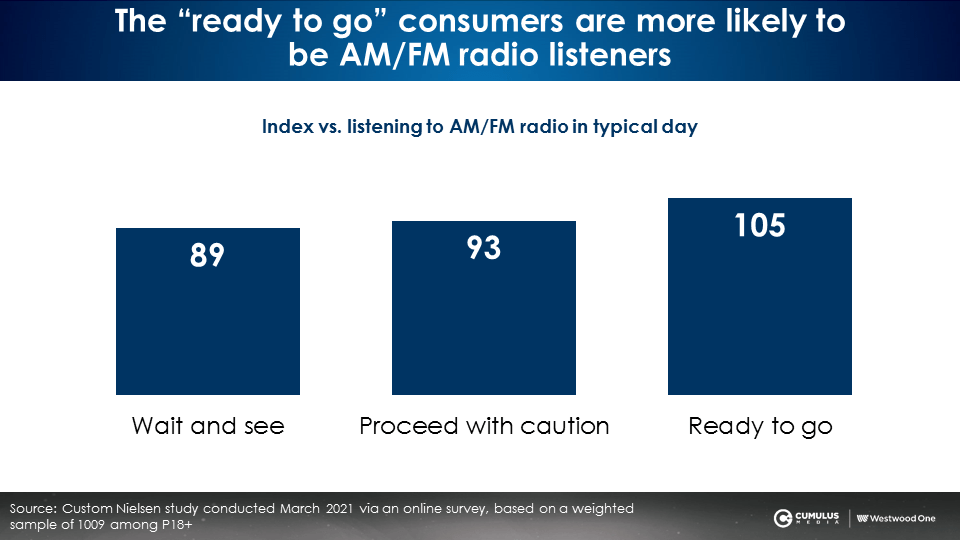
Travel: As restrictions ease up, Americans are eager to get out of town
The travel sector was one of the hardest hit during the pandemic. Strict guidelines kept more people at home. No longer. Air travel is up sharply.
According to the U.S. Transportation Security Administration (TSA) travel numbers, the week of May 16-22, 2021 was at 66% of the passenger volume seen pre-pandemic for the same week in 2019. This is up from January when air travel volumes were only at 36% of 2019’s numbers. The recent Memorial Day holiday weekend saw a milestone for daily air travelers, hitting the 1.9 million travelers mark twice for the first time in over a year.
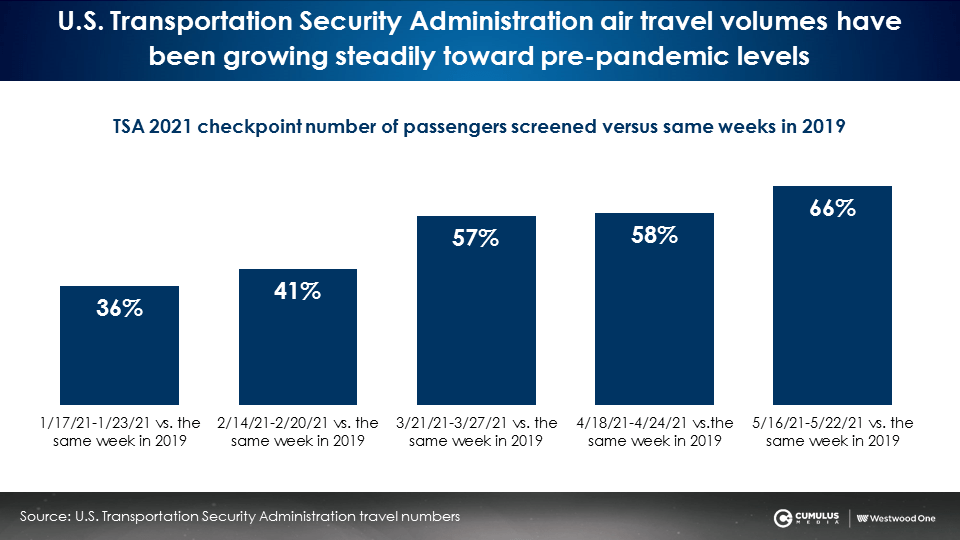
While travel is not completely recovered, Glen Hauenstein, president of Delta Air Lines, says, “Domestic leisure [travel] will be 100% restored by June, with … bookings ahead of 2019 levels and yields essentially recovered.” According to CNN Business, “Airlines expect business travel will start to return once offices that had employees working remotely begin to reopen.”
Travel: Podcast listeners and heavy AM/FM radio listeners are more likely to plan/book a vacation versus the average consumer
For reaching soon-to-be travelers, advertisers need look no further than podcasts and AM/FM radio. According to the Nielsen consumer study, 24% of heavy AM/FM radio listeners intend to plan or book a vacation within a month after COVID-19 eases in their area, +41% more than heavy TV viewers. Podcast listeners are even more likely with 33% saying they intend to plan or book within a month.
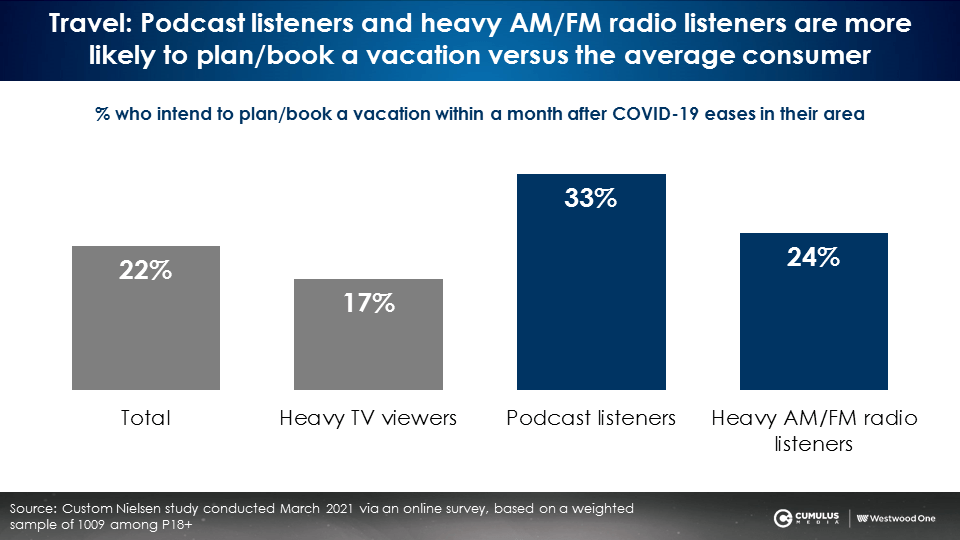
Similarly, more heavy AM/FM radio listeners (17%) and podcast listeners (13%) intend to travel via airplane within a month after COVID-19 restrictions ease compared to only 5% of heavy TV viewers.
Hotels: Podcast listeners and heavy AM/FM radio listeners are +57% more likely to spend more on hotel reservations within a month of COVID-19 restrictions easing versus the average consumer
Travel is not all about flying. According to the social media analytics company Sprout Social cited by CNBC, “Since April 29, of more than 1.6 million travel-related conversations on Twitter, road trips were mentioned more than 32,000 times and flights 22,000 times.” Many travelers are staying local.
For hotels looking to capture road tripper dollars, AM/FM radio and podcasts offer audiences who are +57% more likely to spend more on hotel reservations post-COVID than the average consumer.
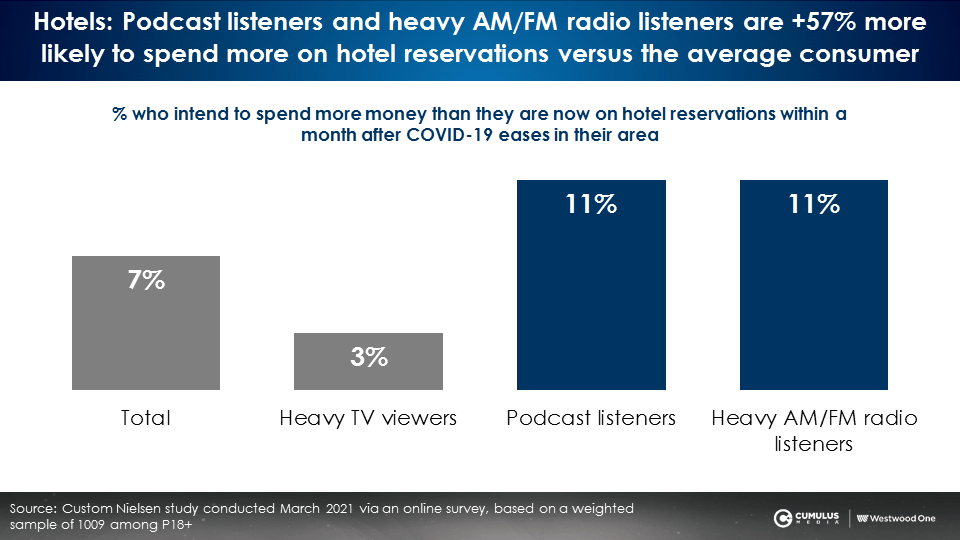
Auto: Podcast listeners (+43%) and AM/FM radio listeners (+18%) are more likely to make an auto purchase in the next 12 months
Another sector seeing positive movement is the auto industry. Forbes reports, “Cox Auto raised its prediction for total 2021 new vehicle sales to 16.1 million from 15.7 million. However much of that growth is likely to come from the sale of high-priced luxury vehicles and pickup trucks leading Cox’s Jonathan Smoke to predict, ‘This spring is going to be one for the record books, I believe. If we had more supply we’d shatter sales records too. But at least we know it’s going to be one for the record books from a pricing perspective.’” CarGurus’ Kevin Roberts continues, “I would expect the economy to be quite hot as we head into the second half of the year.”
For auto dealers, that means turning to AM/FM radio and podcasts. Nielsen reports one-third of heavy AM/FM radio listeners intend to make an auto purchase in the next year, +18% greater than heavy TV viewers. Podcast listeners are even more likely with 40% intending to purchase or lease in the next 12 months.
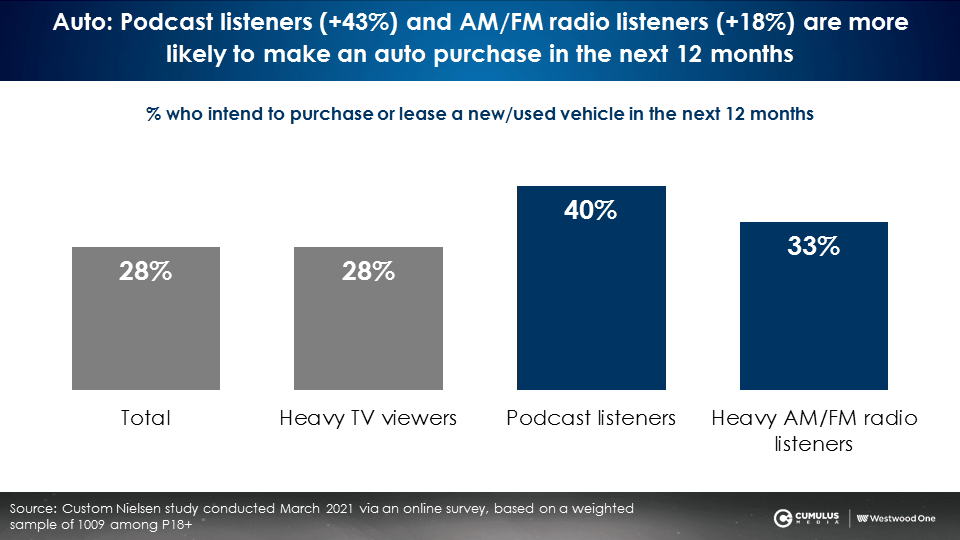
Restaurants: Heavy AM/FM radio listeners and podcast listeners are more likely to dine out
The restaurant industry was another hard-hit category during the pandemic that is now seeing positive momentum. The Washington Post says restaurant traffic is “rocketing back,” continuing: “Restaurant reservations, including diners who placed themselves on waiting lists, were up 46 percent in April compared with April 2019, according to the review site Yelp (and up 23,000 percent compared with April 2020, when most Americans began staying at home during the pandemic).”
The best way to reach these diners? AM/FM radio. 63% of heavy AM/FM radio listeners intend to dine out at either a quick serve or sit-down restaurant within a month. Over half of podcast listeners also intend to dine out after COVID-19 restrictions ease.
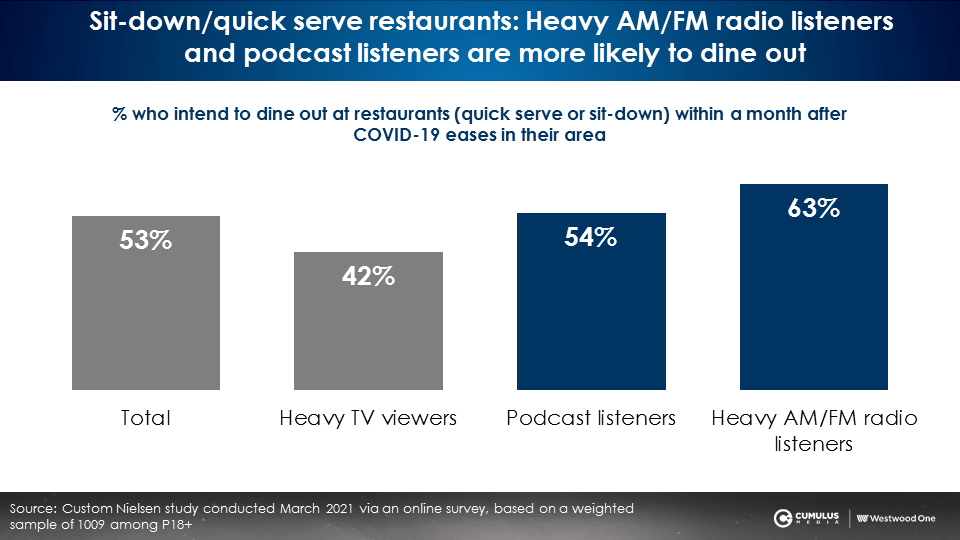
Economic recovery offers advertisers an opportunity to make the most of their advertising
Recessions are complicated but so is recovery. While the upheaval of the last year had many industries scrambling, the reemergence is a chance for advertisers to optimize their advertising budgets and focus on ways to reach consumers who are ready to spend. There are seven strategies for advertisers who need to work now to regain relevance after the uncertainty of the pandemic:
- Ensure share of voice exceeds share of market
- Continue to advertise: According to the World Advertising Research Center (WARC)/Millward Brown, it can take up to 5 years for brands to recover from “going dark”
- Optimize creative by testing ads for more memorable brand effects: Superior creative can generate outsized lifts on ROI and sales effect
- Shift more resources to brand building versus sales activation
- Place a greater emphasis on emotional campaigns to build your brand more strongly
- Shift budget to AM/FM radio to grow reach even if total budgets are reduced
- Focus on, and keep in touch with, the customer, a brand’s biggest asset
Focus on share of voice, optimized creative, and brand building and emotional campaigns. With stronger branding and a shift in budget to AM/FM radio and podcasts, travel advertisers, airlines, hotels, auto dealers, and restaurants can strategically recover from the pandemic.
Key findings:
- Nielsen consumer study: More Americans are “ready to go” than ever
- The “ready to go” segment perceives less risk, feels safer, and indicates their cities are emerging from crisis
- The “ready to go” segment is an attractive consumer group made up of AM/FM radio listeners
- Travel: Podcast listeners and heavy AM/FM radio listeners are more likely to plan/book a vacation versus the average consumer
- Hotels: Podcast listeners and heavy AM/FM radio listeners are +57% more likely to spend more on hotel reservations within a month of COVID-19 restrictions easing versus the average consumer
- Auto: Podcast listeners (+43%) and AM/FM radio listeners (+18%) are more likely to make an auto purchase in the next 12 months
- Restaurants: Heavy AM/FM radio listeners and podcast listeners are more likely to dine out
Lauren Vetrano is Director of Content Marketing at CUMULUS MEDIA | Westwood One.
Contact the Insights team at CorpMarketing@westwoodone.com.